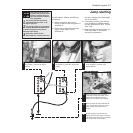
Weekly checks 0•11
Engine oil level
Before you start
4 Make sure that your car is on level ground.
4 Check the oil level before the car is driven,
or at least 5 minutes after the engine has been
switched off.
The correct oil
Modern engines place great demands on their
oil. It is very important that the correct oil for
your car is used (See “Lubricants, fluids and
tyre pressures”).
Car Care
l If you have to add oil frequently, you should
check whether you have any oil leaks. Place
some clean paper under the car overnight,
and check for stains in the morning. If there
are no leaks, the engine may be burning oil
(see “Fault Finding”)
.
l Always maintain the level between the
upper and lower dipstick marks (see photo 3).
If the level is too low severe engine damage
may occur. Oil seal failure may result if the
engine is overfilled by adding too much oil.
If the oil is checked
immediately after driving the
vehicle, some of the oil will
remain in the upper engine
components, resulting in an inaccurate
reading on the dipstick!
The dipstick top is often brightly coloured
for easy identification (see “Underbonnet
check points” on page 0•10 for exact
location). Withdraw the dipstick.
Using a clean rag or paper towel remove
all oil from the dipstick. Insert the clean
dipstick into the tube as far as it will go,
then withdraw it again.
Note the oil level on the end of the
dipstick, which should be between the
upper ("MAX") mark and lower ("MIN")
mark. Approximately 1.0 litre of oil will raise the
level from the lower mark to the upper mark.
Oil is added through the filler cap.
Unscrew the cap and top-up the level; a
funnel may help to reduce spillage. Add
the oil slowly, checking the level on the dipstick
often. Don’t overfill (see “Car Care” left).
1 2
3 4
Warning: DO NOT attempt to
remove the expansion tank
pressure cap when the engine
is hot, as there is a very great
risk of scalding. Do not leave
open containers of coolant
about, as it is poisonous.
Car Care
l With a sealed-type cooling system, adding
coolant should not be necessary on a regular
basis. If frequent topping-up is required, it is
likely there is a leak. Check the radiator, all
hoses and joint faces for signs of staining or
wetness, and rectify as necessary.
l It is important that antifreeze is used in the
cooling system all year round, not just during
the winter months. Don’t top-up with water
alone, as the antifreeze will become too
diluted.
Coolant level
The coolant level varies with engine
temperature. When cold, the coolant
level should be between the “MAX” and
“MIN” marks. When the engine is hot, the
level may rise slightly above the “MAX” mark.
Where the expansion tank has a level
indicator inside the expansion tank, the
coolant level should be between the
upper level indicator step (a) and lower step
(b). On all engines, when the coolant is hot,
the level may rise above the “MAX” mark or
level indicator step.
If topping-up is necessary, turn the
expansion tank cap slowly anti-clockwise
and wait until any pressure in the system
is released. Once any pressure is released,
unscrew it fully and lift it off. Add a mixture of
water and antifreeze through the filler neck until
the coolant is at the correct level. Refit the cap,
turning it clockwise as far as it will go to secure.
1
2 3


















